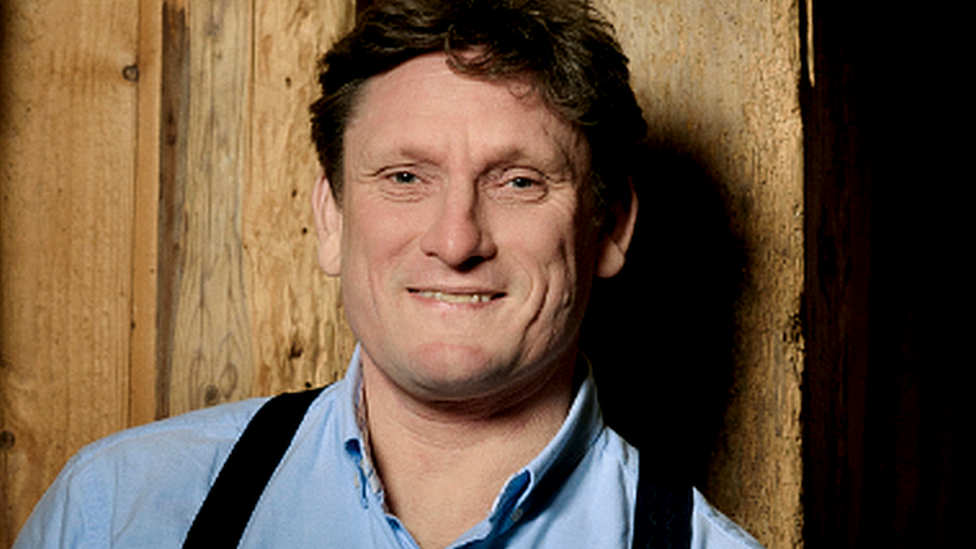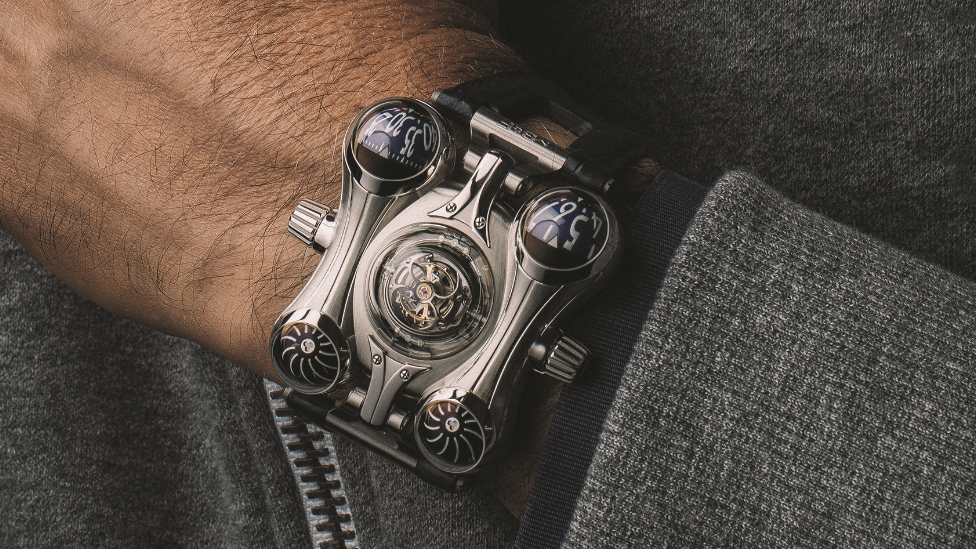Hermes: Where the luxury giant is an industry outsider
- Published

Hermes only moved into men's watches seven years ago. Its new Arceau L'Heure de la Lune sells for £20,500-plus
Hermes may be a big cheese in the world of luxury goods, but in the world of Swiss watchmaking it is something of an outsider.
First, it is French. Second, it's a relative newcomer. Third, the bulk of its watches are aimed at women in a still male-dominated industry.
Hermes is at this week's Salon International de la Haute Horlogerie (SIHH) watch fair in Geneva, where the display cabinets are weighed down with chunky timepieces as complicated as a Ferrari car (but frequently cost more).
"We are one of the challengers to an industry that is 300 years old," says Laurent Dordet, who heads the watch division, La Montre Hermes. He knows there's a lot of work to do "to become legitimate and accepted".
It helps being at this week's annual watch event, an invitation-only affair where Switzerland's most exclusive brands and artisan workshops unveil their latest products.
Paris-based Hermes is allowed in because it makes its watches in Switzerland. The listed, but still family-owned company, better known for its leather and silk products, got into ladies' watches about four decades ago, and men's in 2012.
But it is only in recent years that it became a more serious player, investing heavily to buy up Swiss component makers.

Laurent Dordet believes Hermes is challenging "an industry that is 300 years old"
La Montre Hermes now produces all the dials, cases, and movements in-house - unlike some competitors. The division employs about 300 people, a fraction of the 13,000 employed in the core businesses.
Mr Dordet, a Hermes lifer, used to run the leather goods business, where his products were at the top of the luxury tree.
In the industry, Hermes' leather watch straps were as highly regarded as the watches. It makes straps for brands such as Parmigiani, and they are also available for the Apple Watch.
Now, since his appointment in 2015, he's running an operation where the brand must work harder to get noticed. "It's a challenge," Mr Dordet says.
He's been taking La Montre Hermes up the value chain. The business used to trade in the €2,000-€3,000 ($2,280-$3,420; £1,770-£2,660) bracket. Pricy to most people, but not in the world of fine watches.
But having a completely in-house operation means Hermes can design and produce far more complicated pieces, not just in the looks but the mechanics inside.
Hermes' standard watches now cost as much as €30,000, while special pieces with jewels are €100,000-plus.
Ariel Adams, founder of the closely-read website ablogtowatch.com, says female fashion house watches - where the product is just one of many luxury items - have traditionally not been taken as seriously as those produced by firms that only make timepieces.
"There has been an unfortunate bias by collectors against watch brands that appear to primarily produce products for women," he says.
"I've personally never quite understood this. Perhaps it is the large assortment of comparatively inexpensive women's fashion watches that have prevented more high-end customers from taking the watches more seriously."

Despite its simple design, Mr Dordet says the shape of the Galop d'Hermes made it one of the most complicated pieces to produce
Mr Dordet wants to challenge that bias. Hermes' new products on display at SIHH are among the most complicated yet, he says. Its Galop d'Hermes woman's watch is not round and not symmetrical (as most watches are). That in itself makes developing the movement more difficult.
It's a watch that he hopes will be appreciated not only for its design (which perhaps is the thing most consumers only consider), but its mechanics.
Female executives
"It's not a classic [female] watch," Mr Dordet says, adding in marketing-speak that could only come from a luxury goods executive: "It's a futuristic object for today's femininity... a woman of movement, a working person, full of projects."
What he means is that the female watch consumer is changing - less bling and sparkle, and timepieces embedded in necklaces or brooches; and more for traditional, and slightly larger, wristwatches.
Mr Dordet adds that it will be interesting to see how the industry changes as more female executives enter the business.

Fabienne Lupo, one of a growing number of female executives in the industry
In 2017, Chabi Nouri became the first woman chief executive of Piaget, while Catherine Reiner's appointment last year as boss of the 175-year-old Jaeger-LeCoultre was also a female first.
And the managing director of the Fondation de la Haute Horlogerie, which organises SIHH, is female, Fabienne Lupo.
Smartwatch threat
What of Hermes' men's watches, a business started only seven years ago? It could be an uphill struggle.
"When you have a stamp on your forehead that says you are mainly a female fashion brand it's hard to convince the guys," says Mr Dordet.
"We are winning more respect from male customers year after year. But it's slow because we are coming into a world where well-established men's brands have existed for decades, even centuries," he says.
Ariel Adams is a fan, though. "What they may lack in sheer exclusivity they make up for in a practical luxury appeal."
But Hermes is entering a crowded market, he adds.
Interestingly, Hermes has looked into the possibility of putting smart tech in watches, an area perhaps more attractive to male consumers.
However, it has discounted the move, for the moment at least. "We haven't closed the door on it, but our conclusion is that this is not the time," Mr Dordet says.
But, just as Hermes is establishing itself as a serious watch player, does Mr Dordet think smartwatches threaten the mechanical industry?
"Absolutely not. Smartwatches are cold, functional objects," he says.
"Fine watches are an experience, a jewel, a luxury, an emotion," he adds. "One thing we are all sure of [at SIHH] is that people don't buy watches any more to see what time it is."
- Published16 January 2019

- Published15 January 2019

- Published13 January 2019
